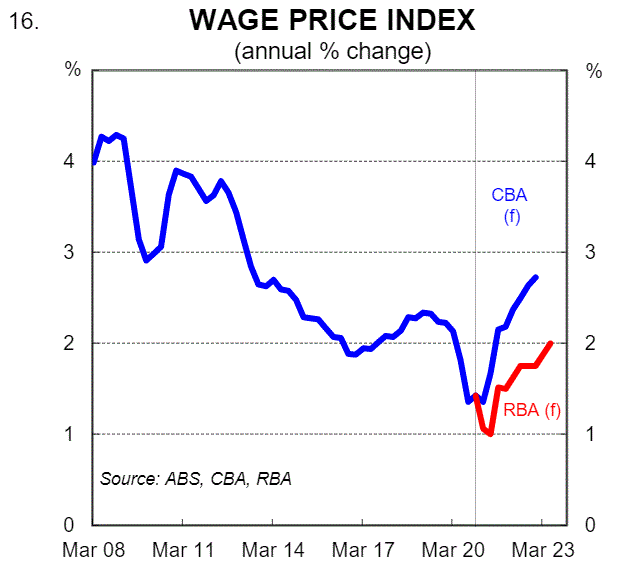From the excellent Garth Aird, chief economist at CBA. Note that my own view is that a terms of trade shock is coming down the pipe to hose off the price and growth bullishness in 2022:
The Australian economic recovery from the COVID‑19 recession has been a lot stronger and a lot faster than the official forecasting family of the Commonwealth Treasury and the RBA expected (chart 1). In truth it has been a lot stronger than most forecasters anticipated.
Regular readers will be aware that CBA Economics has had a bullish outlook on the domestic economy for some time. Indeed in November 2020 when we forecast the unemployment rate to be 5.7% at end‑2021 it seemed like a very ambitious call (at the time the consensus for the unemployment rate at end‑2021 was 7.0% and the RBA’s forecast was 6.5%).
Hindsight is of course a wonderful thing. And the strength of the labour market over the early part of 2021 has surprised the entire forecasting fraternity, which of course includes us. Employment has returned to its pre‑COVID level sooner than we anticipated and as a result the unemployment rate has dropped faster than we expected. It is excellent news, but actual outcomes are backward looking while financial markets are forward looking.
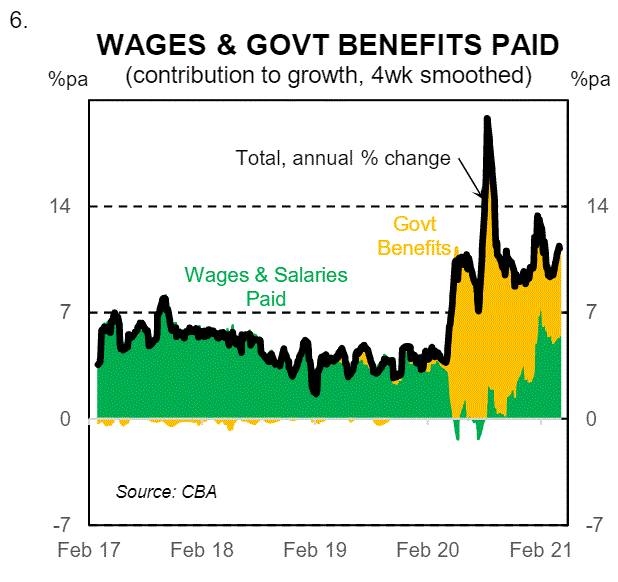
Measures of labour demand matter for the outlook. And currently they look very healthy indeed. Job vacancies and hiring intentions suggest that with the participation rate back to its pre‑COVID‑19 levels the unemployment rate could drop very quickly (chart 2). The strength of the forward looking indicators of labour demand also indicate that the expiry of JobKeeper will not be particularly problematic for the labour market as a whole.
The recent negative news on Australia’s vaccine rollout is a setback and points to a delay in international services trade resuming. But it does not shift the dial for domestic demand in 2021 provided any outbreaks of COVID‑19 are traced and well contained and significant restrictions are not reimposed for an extended period. We acknowledge, however, that the risks of COVID‑related distributions to economic activity have risen.
Notwithstanding, based on the strength of key economic data overlaid with themes emanating from our recent interstate client visits we have made some modest upward revisions to our profile for GDP and some more material downward revisions to our profile for the unemployment rate. Mechanically this lifts our forecasts for consumer inflation and wages growth.
We upgrade our forecast for GDP growth to be 4.7% in 2021 (versus 4.4% previously). Our forecast for GDP growth of 3.7% in 2022 is unchanged, but the overall level of GDP in 2022 steps up due to a stronger growth rate in 2021. We expect the unemployment rate to be 5.0% at end‑2021 (versus 5.5% previously). Our profile sees the unemployment rate at 4.7% at end‑2022.
We forecast underlying inflation to accelerate to 1.9%/yr at end‑2021 and 2.2%/yr by end‑2022. Annual wages growth, as measured by the Wage Price Index, is forecast to be 2.2% at end‑2021 and 2.7% at end‑2022.
GDP in 2022 will be influenced by population growth which is a key source of uncertainty at the moment. We do not know the Government’s timeline for reopening the international borders and by extension their migration program planning levels. That said, population growth has minimal impact on GDP per capita so we have high conviction that the unemployment rate will drop much more quickly than the consensus expects (the unemployment rate is essentially a per capita measure).
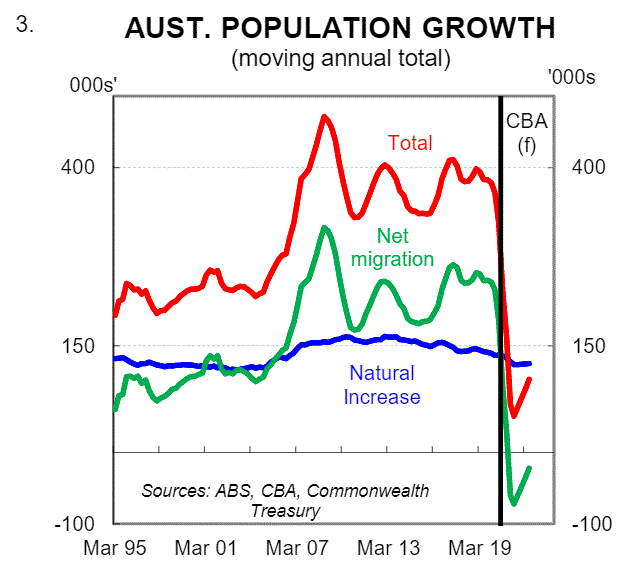
Our forecasts for wages growth and consumer inflation, however, carry a greater degree of uncertainty given the inherent difficulty in estimating the NAIRU (or non‑accelerating inflation rate of unemployment). Notwithstanding, we believe that the NAIRU has lifted due to the sudden drop in net overseas migration.
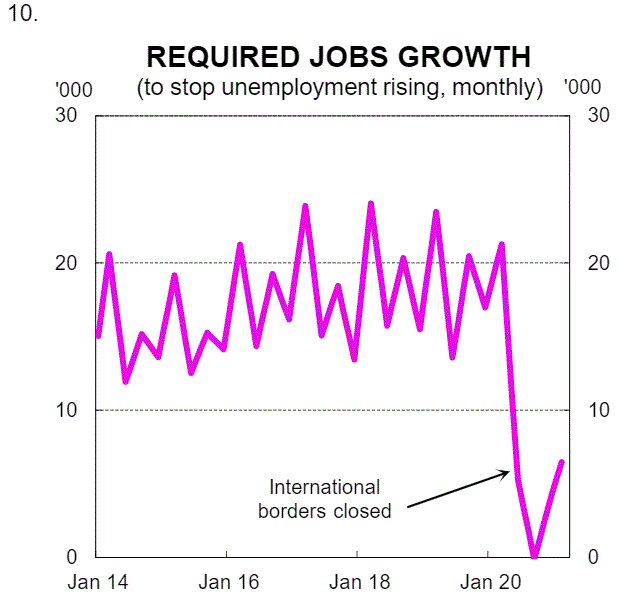
It may be the case that wages and underlying inflation lift a little earlier than our profile implies given that pockets of skill shortages are already emerging. But it could also be the case that wages growth stalls in mid‑2022 if growth in the supply of labour accelerates too quickly when the international borders are reopened. The risks therefore around our wages forecasts look evenly balanced.
From a monetary policy perspective our updated forecasts for consumer inflation and wages growth are consistent with the RBA leaving the cash rate on hold through to end‑2022. Our economic forecasts do not yet extend to 2023 so our call for the cash rate is simply “on hold”. However, our expected trajectory for wages and inflation over our forecast horizon challenges the RBA’s 2024 calendar based forward guidance.
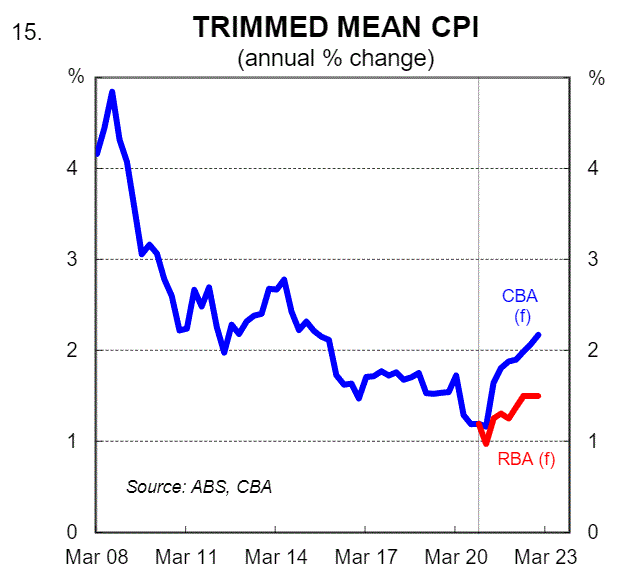
In the more immediate future our updated economic forecasts are consistent with the RBA reducing the pace of its bond purchases when the current second round of $A100bn of QE ends (i.e. a taper). The RBA has stated that they are “prepared to undertake further bond purchases if doing so would assist with progress towards the goals of full employment and inflation”. We expect that at the July Board meeting the RBA will turn this implicit forward guidance into an explicit commitment to a third round of QE, but at the reduced size and pace of $A50bn over six months.
This note articulates our latest views on the Australian economic outlook with a particular focus on the labour market, wages, inflation and our RBA call.

